Validating a Landsat Time-Series of Fractional Component Cover Across Western U.S. Rangelands
Abstract
1. Introduction
2. Materials and Methods
2.1. Method Overview
2.2. Field Observations
2.3. HRS Prediction
2.4. Base Map
2.5. BIT Predictions
2.6. Data Analysis
3. Results
3.1. Temporal Correlations
3.2. Spatio-Temporal Correlations
3.3. Climate Relationships
4. Discussion
4.1. Methodological Concerns
4.2. Application
5. Conclusions
Author Contributions
Funding
Acknowledgments
Conflicts of Interest
References
- Xian, G.; Homer, C.; Rigge, M.; Shi, H.; Meyer, D. Characterization of shrubland ecosystem components as continuous fields in the northwest United States. Remote Sens. Environ. 2015, 168, 286–300. [Google Scholar] [CrossRef]
- Rigge, M.; Homer, C.; Cleeves, L.; Meyer, D.; Bunde, B.; Shi, H.; Xian, G.; Bobo, M. Quantifying western U.S. rangelands as fractional components with Landsat. Ecol. Indic. 2019. In review. [Google Scholar]
- Gómez, C.; White, J.C.; Wulder, M.A. Optical remotely sensed time series data for land cover classification: A review. ISPRS J. Phtoogramm. 2016, 116, 55–72. [Google Scholar] [CrossRef]
- Shi, H.; Rigge, M.; Homer, C.G.; Xian, G.; Meyer, D.K.; Bunde, B. Historical Cover Trends in a Sagebrush Steppe Ecosystem from 1985 to 2013: Links with Climate, Disturbance, and Management. Ecosystems 2018, 21, 913–929. [Google Scholar] [CrossRef]
- Rigge, M.; Shi, H.; Homer, C.; Danielson, P.; Granneman, B. Long-term trajectories of fractional component change in the Northern Great Basin, USA. Ecosphere 2019, 10. [Google Scholar] [CrossRef]
- Vogelmann, J.E.; Gallant, A.L.; Shi, H.; Zhu, Z. Perspectives on monitoring gradual change across the continuity of Landsat sensors using time-series data. Remote Sens. Environ. 2016, 185, 258–270. [Google Scholar] [CrossRef]
- Congalton, R. Accuracy assessment and validation of remotely sensed and other spatial information. Int. J. Wildland Fire 2001, 10, 321–328. [Google Scholar] [CrossRef]
- Foody, G.M. Status of land cover classification accuracy assessment. Remote Sens. Environ. 2002, 80, 185–201. [Google Scholar] [CrossRef]
- Verbesselt, J.; Hyndman, R.; Newnham, G.; Culvenor, D. Detecting trend and seasonal changes in satellite image time series. Remote Sens. Environ. 2010, 114, 106–116. [Google Scholar] [CrossRef]
- Potapov, P.V.; Dempewolf, J.; Talero, Y.; Hansen, M.C.; Stehman, S.V.; Vargas, C.; Rojas, E.J.; Castillo, D.; Mendoza, E.; Calderón, A.; et al. National satellite-based humid tropical forest change assessment in Peru in support of REDD+ implementation. Environ. Res. Lett. 2014, 9, 124012. [Google Scholar] [CrossRef]
- Jamali, S.; Eklundh, L.; Ardö, J.; Seaquist, J.; Jönsson, P. Detecting changes in vegetation trends using time series segmentation. Remote Sens. Environ. 2015, 156, 182–195. [Google Scholar] [CrossRef]
- Kennedy, R.E.; Cohen, W.B.; Schroeder, T.A. Trajectory-based change detection for automated characterization of forest disturbance dynamics. Remote Sens. Environ. 2007, 110, 370–386. [Google Scholar] [CrossRef]
- Sleeter, B.M.; Sohl, T.L.; Loveland, T.R.; Auch, R.F.; Acevedo, W.; Drummond, M.A.; Sayler, K.L.; Stehman, S.V. Land-cover change in the conterminous United States from 1973 to 2000. Glob. Environ. Chang. 2013, 23, 733–748. [Google Scholar] [CrossRef]
- Tsutsumida, N.; Comber, A.J. Measures of spatio-temporal accuracy for time series land cover data. Int. J. Appl. Earth Obs. 2015, 41, 46–55. [Google Scholar] [CrossRef]
- Wickham, J.; Stehman, S.V.; Gass, L.; Dewitz, J.A.; Sorenson, D.G.; Granneman, B.J.; Poss, R.V.; Baer, L.A. Thematic accuracy assessment of the 2011 National Land Cover Database (NLCD). Remote Sens. Environ. 2017, 191, 328–341. [Google Scholar] [CrossRef]
- Smith, W.K.; Dannenberg, M.P.; Yan, D.; Herrmann, S.; Barnes, M.L.; Barron-Gafford, G.A.; Biederman, J.A.; Ferrenberg, S.; Fox, A.M.; Hudson, A.; et al. Remote sensing of dryland ecosystem structure and function: Progress, challenges, and opportunities. Remote Sens. Environ. 2019, 233, 111401. [Google Scholar] [CrossRef]
- Ellis, E.C.; Wang, H.; Xiao, H.S.; Peng, K.; Liu, X.P.; Li, S.C.; Ouyang, H.; Cheng, X.; Yang, L.Z. Measuring long-term ecological changes in densely populated landscapes using current and historical high resolution imagery. Remote Sens. Environ. 2006, 100, 457–473. [Google Scholar] [CrossRef]
- Ambika, A.K.; Wardlow, B.; Mishra, V. Remotely sensed high resolution irrigated area mapping in India for 2000 to 2015. Sci. Data. 2016, 3, 160118. [Google Scholar] [CrossRef]
- Congalton, R.; Green, K. Assessing the Accuracy of Remotely Sensed Data: Principles and Practices. CRC/Lewis Press: Boca Raton, FL, USA, 1999; p. 137. [Google Scholar]
- Shi, H.; Homer, C.; Rigge, M.; Postma, K.; Xian, G. Assessing fractional component change in a shrubland ecosytem with both long-term field observations and a Landsat time-series in Wyoming USA. J. Veg. Sc. 2019. in review. [Google Scholar]
- Homer, C.G.; Dewitz, J.; Fry, J.; Coan, M.; Hossain, N.; Larson, C.; Herold, N.; McKerrow, A.; VanDriel, J.N.; Wickham, J. Completion of the 2001 National Land Cover Database for the conterminous United States. Photogramm. Eng. Rem. Sens. 2007, 73, 337–341. [Google Scholar]
- Homer, C.G.; Meyer, D.K.; Aldridge, C.L.; Schell, S.J. Detecting annual and seasonal changes in a sagebrush ecosystem with remote sensing-derived continuous fields. J. Appl. Remote Sens. 2013, 7, 073508. [Google Scholar] [CrossRef]
- RuleQuest Research. Cubist, version 2.05; Rule-Quest Pty, St Ives: New South Wales, Australia, 2008. [Google Scholar]
- Hagen, S.C.; Heilman, P.; Marsett, R.; Torbick, N.; Salas, W.; van Ravensway, J.; Qi, J. Mapping total vegetation cover across western rangelands with moderate-resolution imaging spectroradiometer data. Rangel. Ecol. Manag. 2012, 65, 456–467. [Google Scholar] [CrossRef]
- Thornton, P.E.; Thornton, M.M.; Mayer, B.W.; Wilhelmi, N.; Wei, Y.; Devarakonda, R.; Cook, R.B. Daymet: Daily Surface Weather Data on a 1- km Grid for North America, 2nd ed.; ORNL DAAC: Oak Ridge, TN, USA, 2014. [Google Scholar]
- Augustine, D.J.; Booth, D.T.; Cox, S.E.; Derner, J.D. Grazing intensity and spatial heterogeneity in bare soil in a grazing-resistant grassland. Rangel. Ecol. Manag. 2012, 65, 39–46. [Google Scholar] [CrossRef]
- Weber, K.T.; Glenn, N.F.; Tibbitts, J. Investigation of potential bare ground modeling techniques using multispectral satellite imagery. In Final Report: Forecasting Rangeland Condition with GIS in Southeastern Idaho; Weber, K.T., Davis, K., Eds.; Idaho State University: Pocatello, ID, USA, 2010; pp. 101–112. [Google Scholar]
- Pyke, D.A.; Herrick, J.E.; Shaver, P.; Pellant, M. Rangeland health attributes and indicators for qualitative assessment. J. Range Manag. 2002, 55, 584–597. [Google Scholar] [CrossRef]
- Henderson, E.B.; Bell, D.M.; Gregory, M.J. Vegetation mapping to support greater sage-grouse habitat monitoring and management: Multi- or univariate approach? Ecosphere 2019, 10, e02838. [Google Scholar] [CrossRef]
- Homer, C.G.; Aldridge, C.A.; Meyer, D.K.; Schell, S. Multi-Scale Remote Sensing Sagebrush Characterization with Regression Trees over Wyoming, USA.; Laying a Foundation for Monitoring. Int. J. Appl. Earth Obs. 2012, 14, 233–244. [Google Scholar] [CrossRef]
- Li, W.; Gong, P. Continuous monitoring of coastline dynamics in western Florida with a 30-year time series of Landsat imagery. Remote Sens. Environ. 2016, 179, 196–209. [Google Scholar] [CrossRef]
- Jones, M.O.; Allred, B.W.; Naugle, D.E.; Maestas, J.D.; Donnelly, J.D.; Metz, L.J.; Karl, J.; Smith, R.; Bestelmeyer, B.; Boyd, C.; et al. Innovation in rangeland monitoring: Annual, 30m, plant functional type percent cover maps for US rangelands, 1984–2017. Ecosphere 2018, 9, e02430. [Google Scholar] [CrossRef]
- Barker, B.S.; Pilliod, D.S.; Rigge, M.; Homer, C. Pre-fire vegetation drives post-fire outcomes in sagebrush ecosystems: Evidence from field and remote sensing data. Ecosphere 2019, 10, e02929. [Google Scholar] [CrossRef]
- Monroe, A.P.; Aldridge, C.L.; O’Donnell, M.S.; Manier, D.J.; Homer, C.G.; Anderson, P.J. Using remote sensing to quantify recovery of vegetation across space and time following energy development. Ecol. Indic. 2020, 110, 105872. [Google Scholar] [CrossRef]
- Rigge, M. Temporal and Spatio-Temporal High-Resolution Satellite Data for the Validation of a Landsat Time-Series of Fractional Component Cover Across Western, U.S. Rangelands. USA Geol. Surv. 2019. [Google Scholar] [CrossRef]
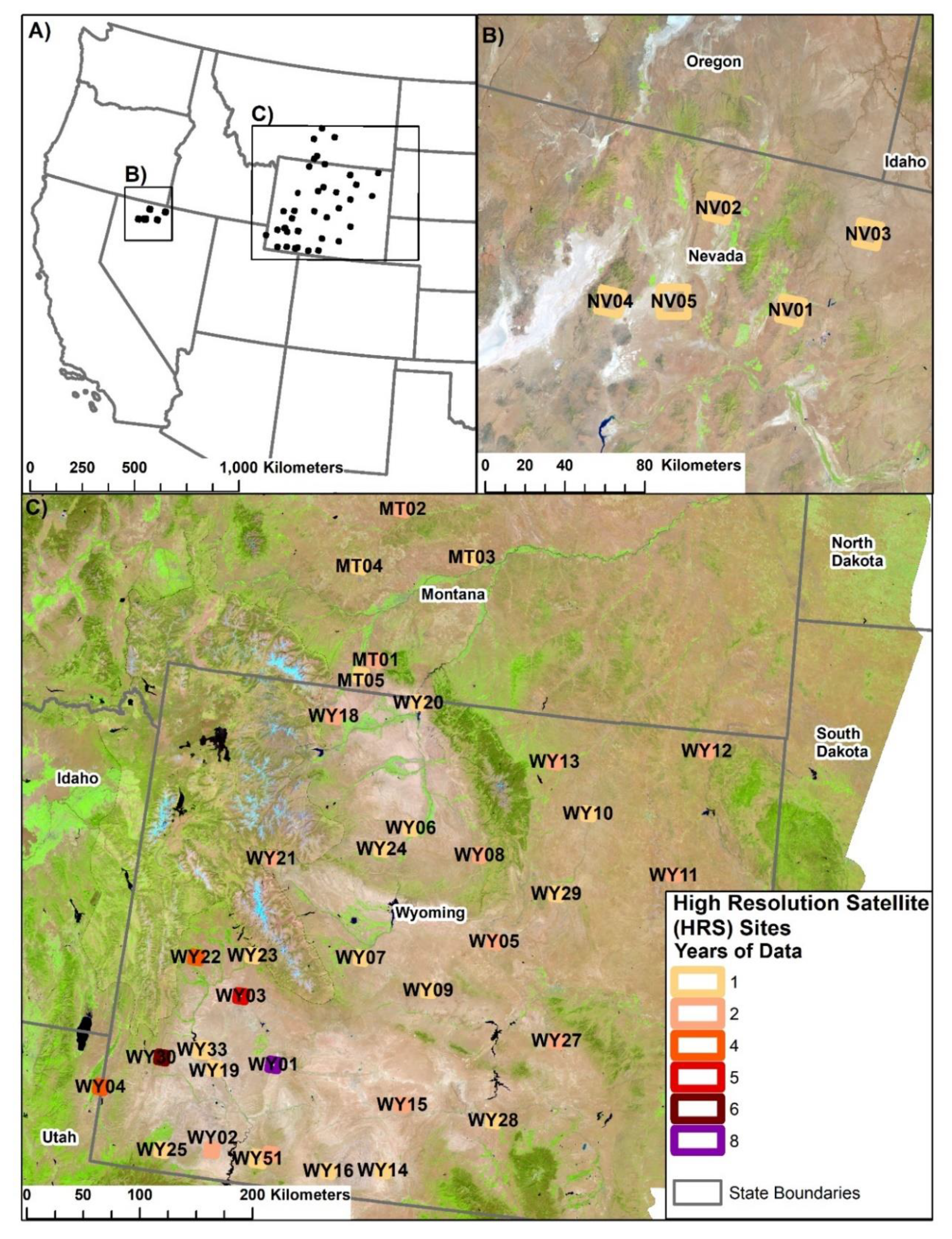
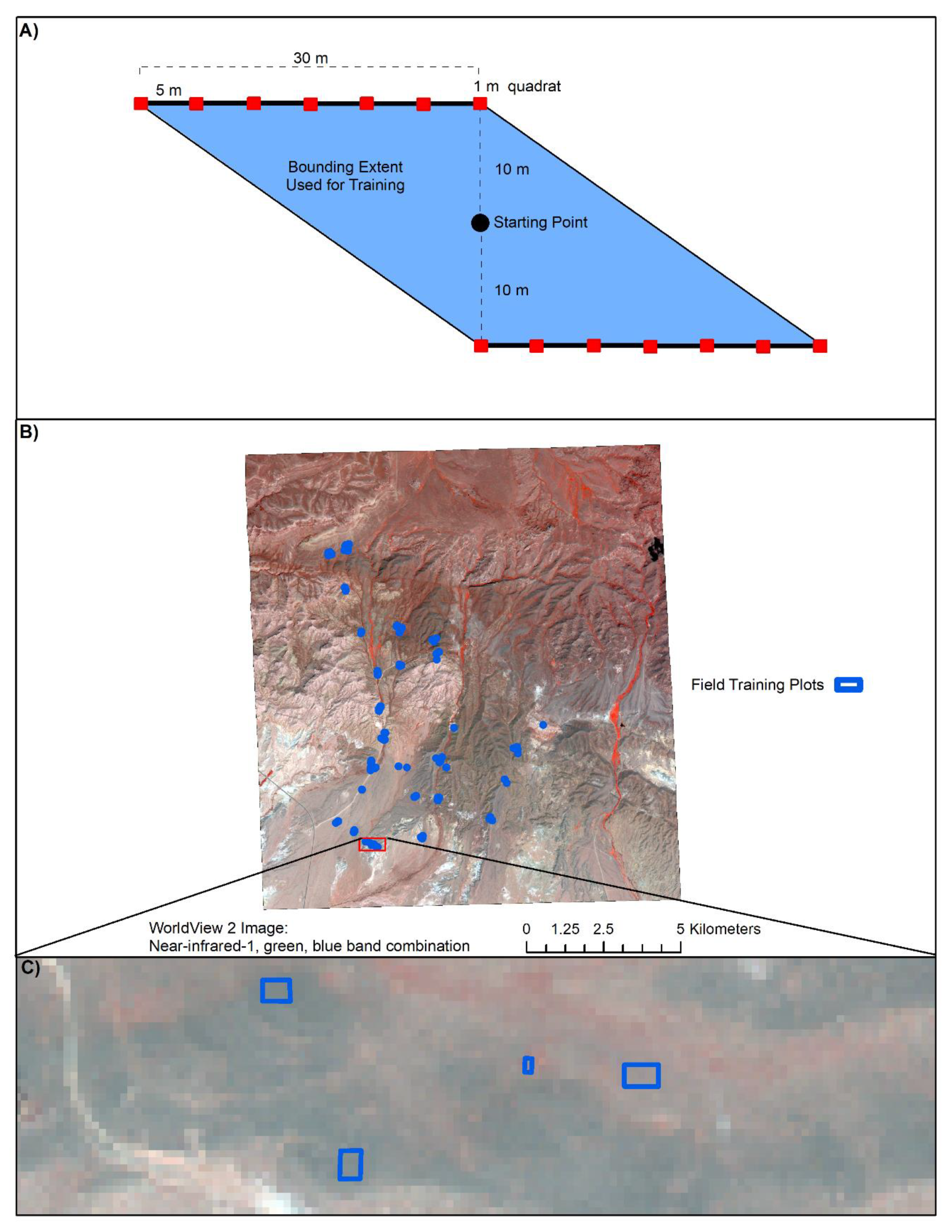
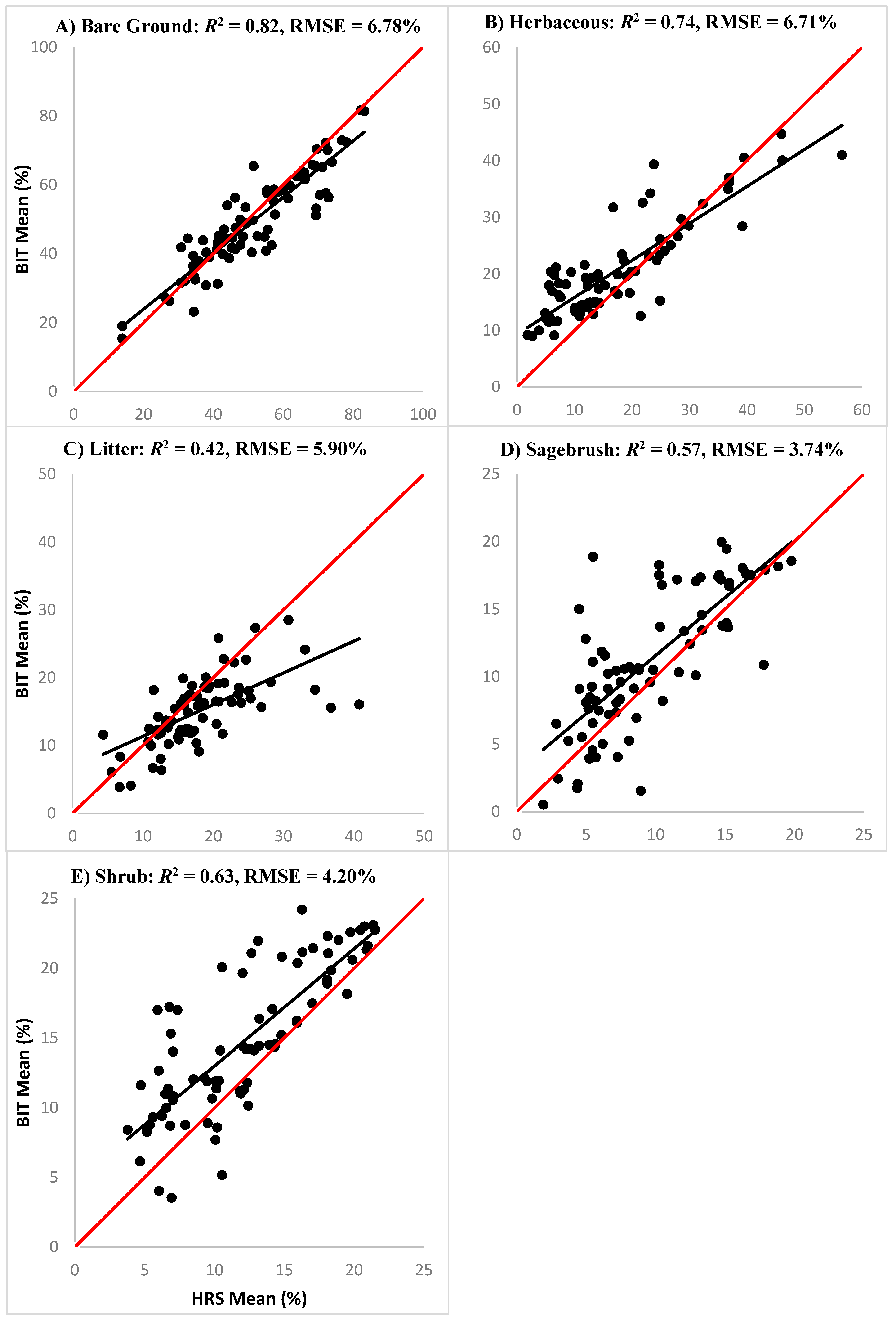
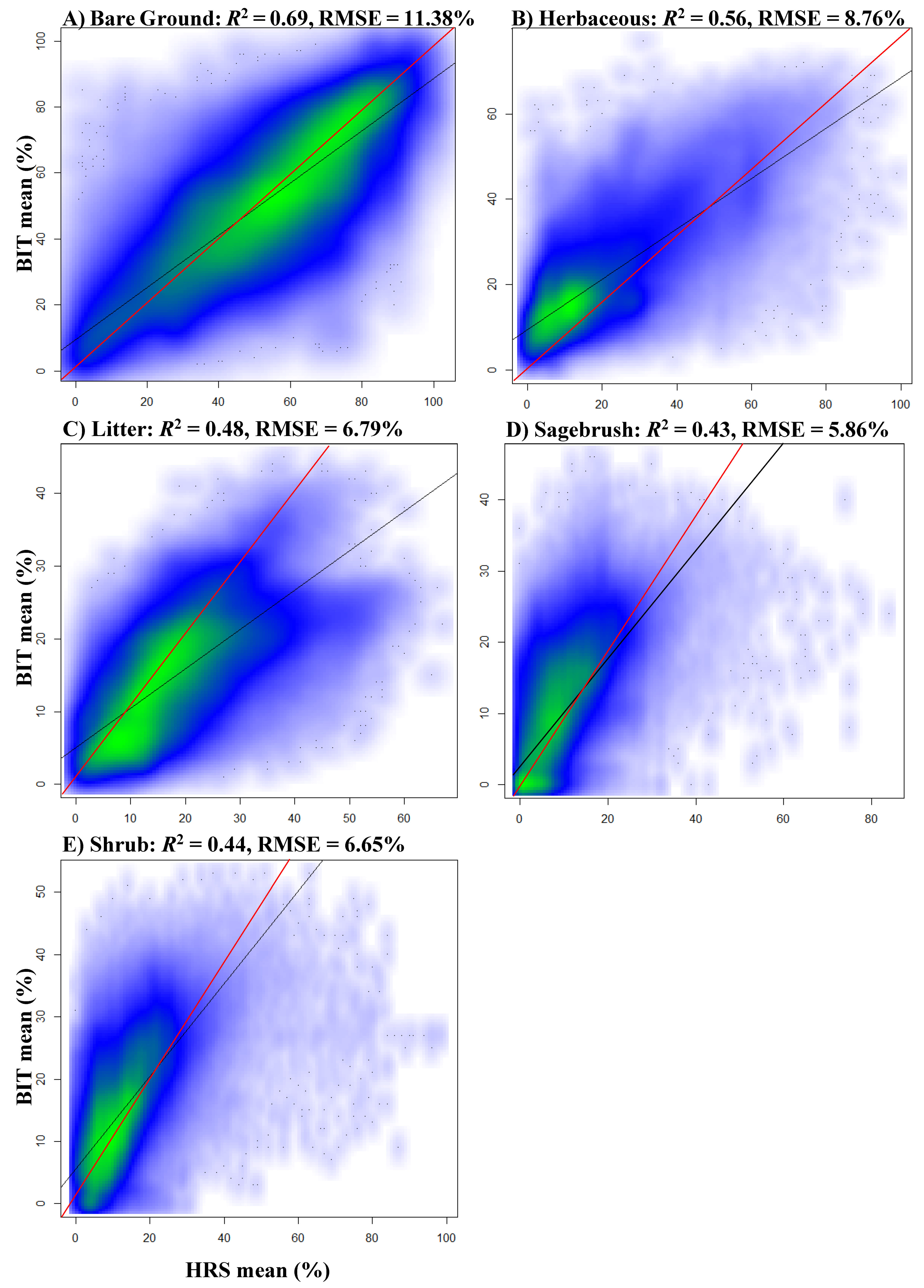
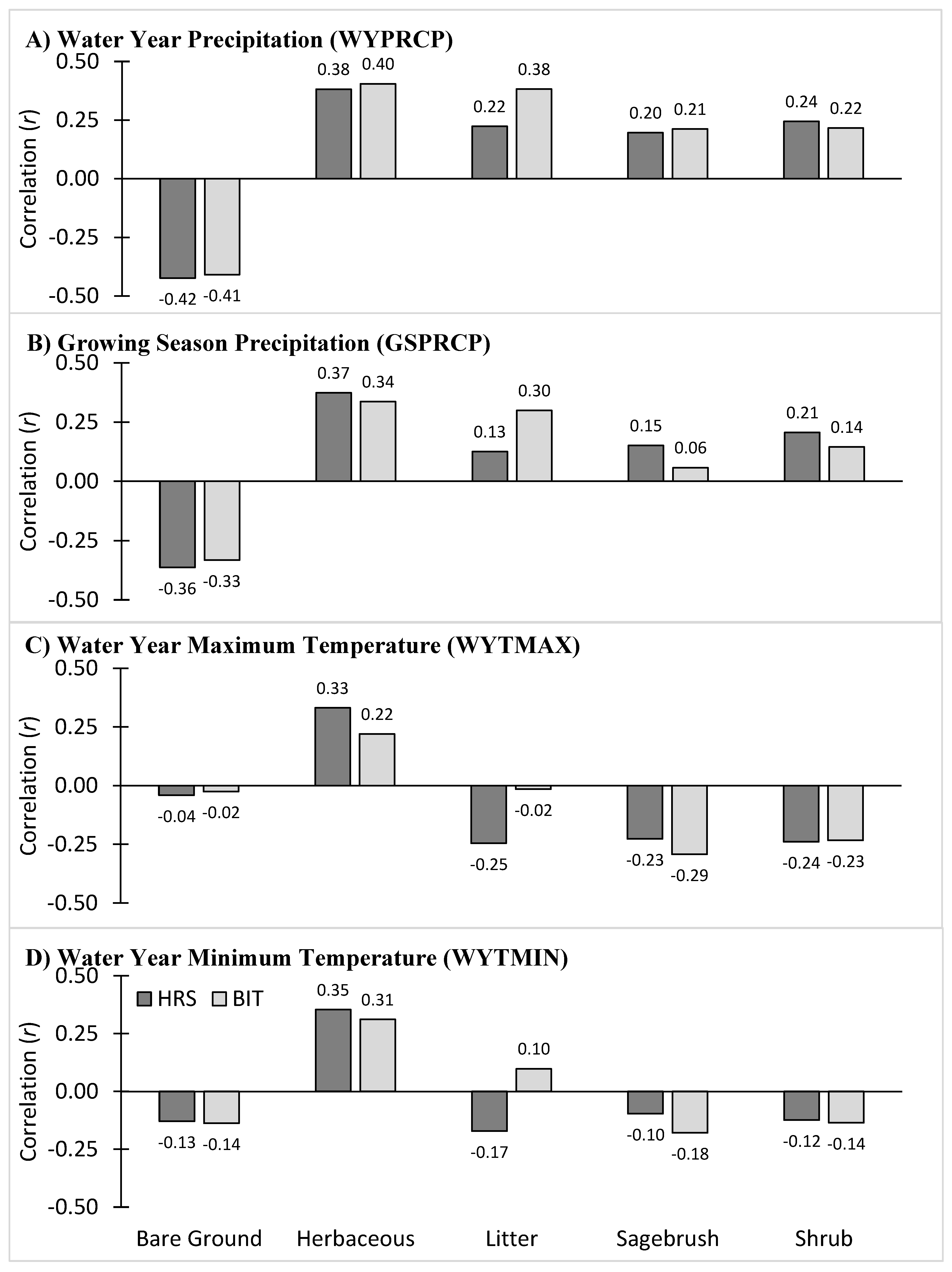
| Site | 2006 | 2007 | 2008 | 2009 | 2010 | 2011 | 2013 | 2015 | 2016 | 2017 |
|---|---|---|---|---|---|---|---|---|---|---|
| WY01 | 8-11 | 7-14 | 7-12 | 8-21 | 6-21 | 7-12 | 7-23 | 8-22 | ||
| WY02 | 7-27 | 7-29 | ||||||||
| WY03 | 8-29 | 7-19 | 6-29 | 8-14 | 6-21 | 7-07 | ||||
| WY04 | 6-13 | 9-03 | 7-01 | 6-18 | ||||||
| WY05 | 7-22 | 8-12 | ||||||||
| WY06 | 6-21 | |||||||||
| WY07 | 7-28 | |||||||||
| WY08 | 8-09 | 7-31 | ||||||||
| WY09 | 6-16 | |||||||||
| WY10 | 6-06 | |||||||||
| WY11 | 6-06 | 6-29 | ||||||||
| WY12 | 6-06 | 6-29 | ||||||||
| WY13 | 6-16 | 6-23 | ||||||||
| WY14 | 9-22 | |||||||||
| WY15 | 10-07 | 6-16 | ||||||||
| WY16 | 6-24 | |||||||||
| WY17 | 9-22 | |||||||||
| WY18 | 6-29 | 7-31 | ||||||||
| WY19 | 9-27 | |||||||||
| WY20 | 7-22 | |||||||||
| WY21 | 8-27 | 8-01 | ||||||||
| WY22 | 7-27 | 9-21 | 6-09 | 9-27 | ||||||
| WY23 | 7-22 | |||||||||
| WY24 | 7-12 | |||||||||
| WY25 | 7-22 | |||||||||
| WY26 | 8-04 | 7-31 | ||||||||
| WY27 | 7-02 | 6-26 | ||||||||
| WY28 | 10-10 | |||||||||
| WY29 | 7-25 | |||||||||
| WY30 | 7-16 | 9-26 | 7-27 | 9-27 | 8-24 | 7-19 | ||||
| WY33 | 7-10 | 6-15 | ||||||||
| WY51 | 8-10 | 10-11 | ||||||||
| NV01 | 6-09 | |||||||||
| NV02 | 6-09 | |||||||||
| NV03 | 8-22 | |||||||||
| NV04 | 7-16 | |||||||||
| NV05 | 7-12 | |||||||||
| MT01 | 9-16 | 6-18 | ||||||||
| MT02 | 9-11 | 6-30 | ||||||||
| MT03 | 8-29 | |||||||||
| MT04 | 8-16 | |||||||||
| MT05 | 8-16 |
| Sensor | QuickBird | RapidEye | Pleiades | WorldView 2/3 |
|---|---|---|---|---|
| Spatial Resolution (m) | 2.4 | 6.5 | 2.0 | 2.0 |
| Coastal | 400–450 | |||
| Blue | 450–520 | 440–510 | 430–550 | 450–510 |
| Green | 520–600 | 520–690 | 490–610 | 510–580 |
| Red | 630–690 | 630–690 | 600–720 | 630–690 |
| Red-edge | 690–730 | 705–745 | ||
| Near-infrared 1 | 760–900 | 760–880 | 750–950 | 770–895 |
| Near-infrared 2 | 860–1040 | |||
| Yellow | 585–625 |
| Time Period | Bare Ground | Herbaceous | Litter | Sagebrush | Shrub |
|---|---|---|---|---|---|
| All other years | 0.82 | 0.74 | 0.42 | 0.57 | 0.63 |
| 2015 | 0.95 | 0.90 | 0.97 | 0.81 | 0.88 |
© 2019 by the authors. Licensee MDPI, Basel, Switzerland. This article is an open access article distributed under the terms and conditions of the Creative Commons Attribution (CC BY) license (http://creativecommons.org/licenses/by/4.0/).
Share and Cite
Rigge, M.; Homer, C.; Shi, H.; K. Meyer, D. Validating a Landsat Time-Series of Fractional Component Cover Across Western U.S. Rangelands. Remote Sens. 2019, 11, 3009. https://doi.org/10.3390/rs11243009
Rigge M, Homer C, Shi H, K. Meyer D. Validating a Landsat Time-Series of Fractional Component Cover Across Western U.S. Rangelands. Remote Sensing. 2019; 11(24):3009. https://doi.org/10.3390/rs11243009
Chicago/Turabian StyleRigge, Matthew, Collin Homer, Hua Shi, and Debra K. Meyer. 2019. "Validating a Landsat Time-Series of Fractional Component Cover Across Western U.S. Rangelands" Remote Sensing 11, no. 24: 3009. https://doi.org/10.3390/rs11243009
APA StyleRigge, M., Homer, C., Shi, H., & K. Meyer, D. (2019). Validating a Landsat Time-Series of Fractional Component Cover Across Western U.S. Rangelands. Remote Sensing, 11(24), 3009. https://doi.org/10.3390/rs11243009





